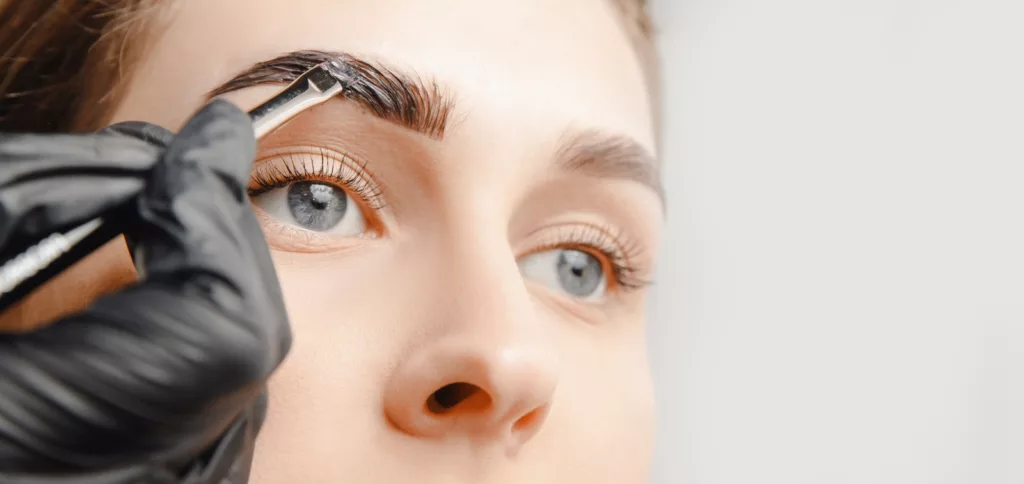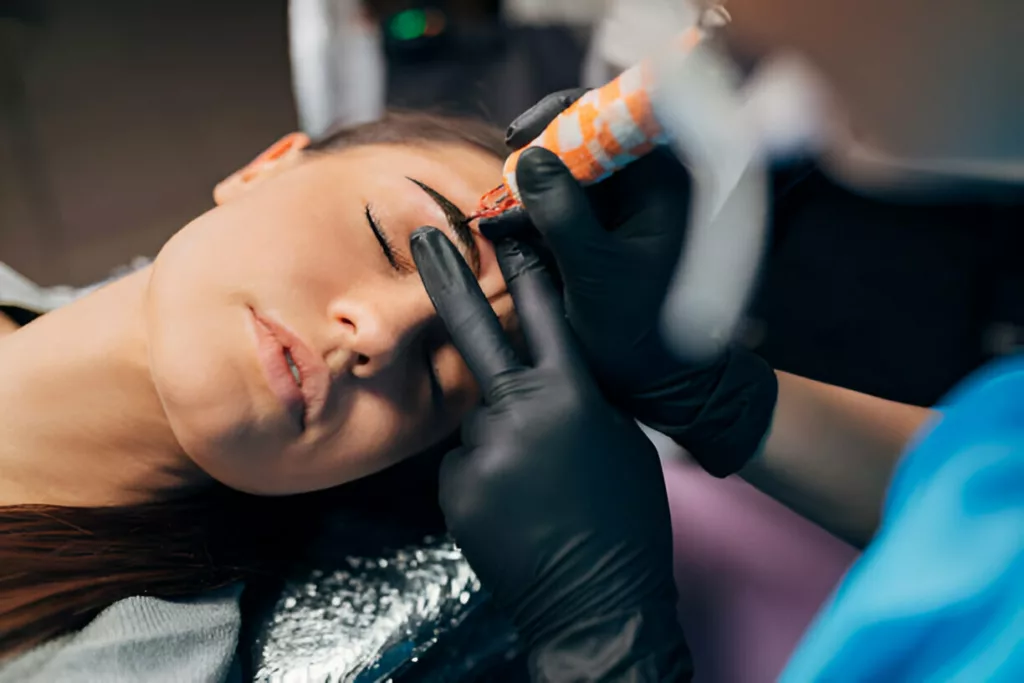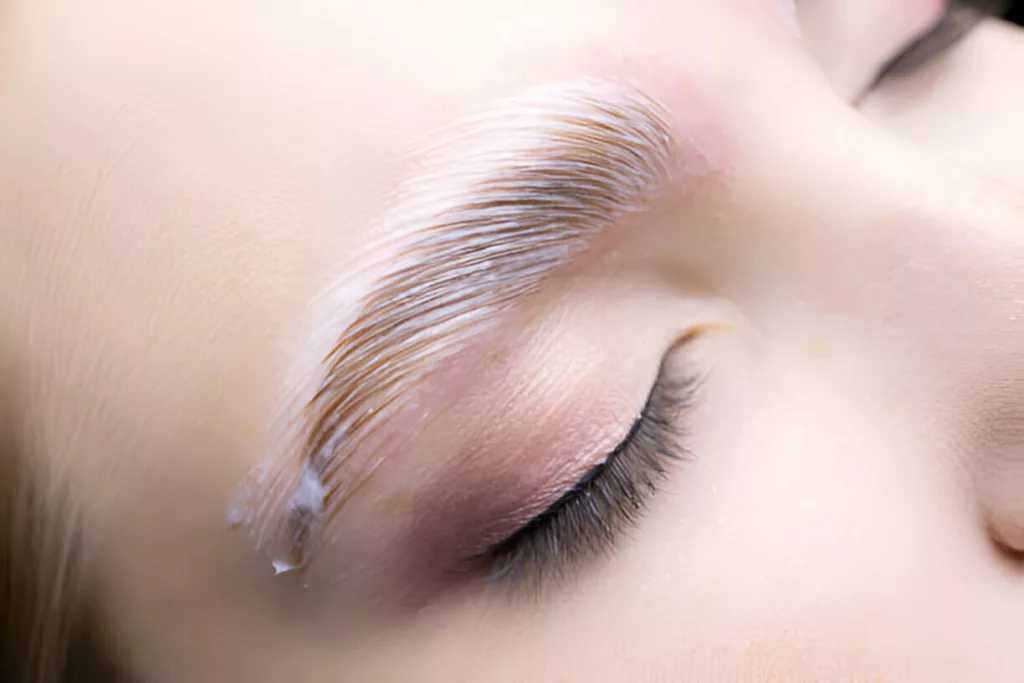Eyebrows are one of the most important facial features, and keeping them in great shape is becoming increasingly popular as part of the anti-aging process. Brow tinting is a quick and effective way to make your eyebrows stand out. If you have thin eyebrows and want to avoid getting an eyebrow tattoo, brow tinting is the perfect solution.
What is Brow Tinting?
Brow tinting is a low-cost, low-risk cosmetic procedure that dyes your eyebrow hair, making it look fresh and bold. The effects last several weeks, giving you a makeup look without needing to set them before going out. Eyebrow tinting is a quick and easy method to improve your eyebrows, making them look darker. The technique of brow tinting is the same as dying your hair.
Tinting your eyebrows has two effects: it colors the eyebrow hair and leaves the skin stained, creating an illusion of fullness. It dyes even the hairs that were previously invisible, making them more defined. The color of the tint can be customized to match your hair color or according to your preference.

Benefits of Brow Tinting
Brow tinting is becoming popular as it reduces the time needed to set your brows. The benefits of brow tinting include;
- Enhanced Look: It makes your eyebrows appear fuller, darker, and more defined.
- Natural Appearance: It enhances your natural eyebrow look, correcting shape, color, and thickness.
- Low Maintenance: The procedure lasts several weeks, reducing the time needed for daily makeup.
- Quick and Affordable: It is an affordable and quick method compared to other long-lasting eyebrow treatments.
- Non-Invasive: Brow tinting is a non-invasive and low-risk procedure compared to treatments like microblading and tattooing.
- Color Customization: The tint color can be customized to match your hair color or personal preference.
Who Should Consider Brow Tinting?
Brow tinting is the perfect solution for anyone with thin eyebrows who desires a fuller and more natural look. Even men find the subtle results appealing. However, there are some cases where brow tinting may not be suitable;
- Avoid if you have cuts or wounds in the eyebrow area.
- It’s not recommended if you’ve had allergic reactions to hair dyes.1McFadden, J. P., White, I. R., Frosch, P. J., Sosted, H., Johansen, J. D., & Menne, T. (2007). Allergy to hair dye. BMJ (Clinical research ed.), 334(7587), 220. https://doi.org/10.1136/bmj.39042.643206.B
- People with skin conditions in the eyebrow area, such as psoriasis, eczema, or rosacea, should also avoid brow tinting.
Brow Tinting Procedure
The brow tinting procedure is more like dying your hair. It is done using a special brow tint for eyebrow tinting.
Your beauty professional will take the following steps while brow tinting;
- Firstly, your eyebrows and the area around them are cleaned using cleansing products or serum.
- They will groom your eyebrow hair and map out the desired shape.2Hetzler L, Sykes J. The brow and forehead in periocular rejuvenation. Facial Plast Surg Clin North Am. 2010;18:375–84.
- Apply petroleum jelly or any barrier cream to avoid staining areas around the eyebrows.
- Next, the dye is carefully applied to the eyebrows, staining the area beneath them in the desired shape.
- The tint is left for 5-15 minutes, depending on the shade and thickness of your eyebrows.
- After that, the tint is washed, and the eyebrows are brushed into place.
- Your beautician may use any serum to make them smooth and glossy.
Can we do brow tinting at home?
Yes, you can perform brow tinting at home, but following safety guidelines to minimize risks is important. Choose a brow tint that matches your hair color and apply it carefully to your eyebrows. Before using the tint, conduct a patch test to check for any allergic reactions. Carefully read and follow the instructions provided with the product, including the recommended application time. The steps for the procedure have been discussed previously.
Aftercare of the Brow Tinting
Brow tinting is a simple technique to make your eyebrows stand out. Its shade lasts only for 4-6 weeks; however, if you want to flaunt the look for longer, you must follow some aftercare guidelines;
- Avoid exposing the eyebrow area to any moisturizer for the first 24 hours after tinting.
- Avoid washing your face in the first few hours and keep it dry.
- You might have some irritation after brow tinting, but avoid touching your brow area.
- Keep your eyebrow area away from sweat, steam, and saltwater.
- Avoid any strenuous physical activity; it may make you sweaty and fade the shade of your eyebrows.
- Limit your sun exposure in the summertime. It may lead to sweating and, eventually, the fading of your brow shade.
- Don’t use anti-aging skin products on the eyebrow area, as they contain skin-lightening agents and may fade the brow shade.
Even with good care, your brow tint will fade over time. Get a touch-up as soon as you start noticing your eyebrow’s natural color is beginning to appear. Remember that frequent tinting can dry out and weaken your eyebrow hair.
Risks associated with Brow tinting
The risks associated with brow tinting include:3American Academy of Ophthalmology. (2023, August 9). Eyebrow and eyelash coloring could harm your vision. American Academy of Ophthalmology. Retrieved from https://www.aao.org/eye-health/news/eyebrow-eyelash-coloring-could-harm-your-vision
- Allergic Reactions: Potential redness, itching, or swelling due to sensitivity to the dye.
- Skin Irritation: Chemical irritation if the dye is applied incorrectly or left on too long.
- Infection: Risk of infection from poor hygiene or contact with open sores.
- Discoloration: Uneven or unexpected coloring if the dye is not applied properly.
- Eye Contact: Irritation if the dye accidentally contacts the eyes.
- Chemical Burns: Rare, but possible if the dye causes a severe reaction on the skin.4Brondeel, K. C., Duggan, R. P., Kirk, K., Palackic, A., & Branski, L. K. (2022). 728 Chemical Burns and Eyebrow Tinting: An Unusual Case. Journal of Burn Care & Research: Official Publication of the American Burn Association, 43(Suppl 1), S170. https://doi.org/10.1093/jbcr/irac012.282
To minimize these risks, perform a patch test, follow application guidelines carefully, and use high-quality products.
Brow Tinting vs. Micro Blading
Both brow tinting and microblading enhance the appearance of eyebrows, but they differ significantly in technique. Microblading involves using a tattoo machine that resembles a pen with tiny needles at the end. These needles create hair-like strokes on the eyebrow area while depositing pigment on the skin’s surface. This method is particularly effective for individuals with sparse or no eyebrows, creating a natural and fuller brow appearance.5Marwah, M. K., Kerure, A. S., & Marwah, G. S. (2021). Microblading and the Science Behind it. Indian Dermatology Online Journal, 12(1), 6–11. https://doi.org/10.4103/idoj.IDOJ_230_206Zhitny VP, Iftekhar N. Ancient roots of microblading- A permanent makeup art. J Skin Stem Cell. 2019;6:e101833.
In contrast, brow tinting uses dye to temporarily color the brow hairs, enhancing their shape and fullness without using blades or permanent pigment.

Procedure for Micro Blading
Microblading takes 1-2 hours. Before the treatment, your stylist will map your eyebrows to create a desirable shape. Next, the numbing cream is used, and this technique uses needles to make hair-like strokes. Needles slightly scratch the skin to penetrate the pigment on the superficial layer of the skin, giving the eyebrow a fine, realistic, and natural look.
Microblading is a semi-permanent technique that lasts 12 to 18 months before the color fades and requires a touch-up.7Marwah, Manjot Kaur; Kerure, Amit S.1; Marwah, Gurjot S.2. Microblading and the Science Behind it. Indian Dermatology Online Journal 12(1):p 6-11, Jan–Feb 2021. | DOI: 10.4103/idoj.IDOJ_230_20
Healing begins in 5-6 days, similar to a tattoo, and you may see flakes on your eyebrows, which is normal. Avoid picking at these flakes to prevent pigment loss. Initially, your eyebrows will look bold and dark due to the fresh pigment, but over the next 30 days, the color will fade slightly as your skin regenerates, revealing a more natural look. You must follow aftercare guidelines to ensure your microblading results last as long as possible.
Just like brow tinting, microblading requires careful aftercare. After microblading, you need to keep your eyebrows dry for the next few days and avoid sun exposure, strenuous activity, and steam to prevent sweating.
Risks associated with Micro Blading
There are a few risks associated with microblading; these may occur from months to years after this cosmetic method. These include8Suleman, S., Villegas, M., Davis, T., Stevens, C. S., & Castaneda, P. (2023). Chronic Granulomatous Reaction to Semi-permanent Eyebrow Tint. Cureus, 15(8), e44070. https://doi.org/10.7759/cureus.44070
- Local inflammation
- Infection
- Contact dermatitis
- Granulomatous reaction
Brow Tinting vs. Lamination

Eyebrow lamination is a new technique that makes your eyebrows look shiny and smooth. Unlike brow tinting, it doesn’t involve coloring. Instead, it perms your eyebrow hair (pull your eyebrow hair in the upward direction) to create a fuller and more even appearance. This semi-permanent method is ideal if you have thin eyebrows or bald spots, giving you even, shiny, and fuller brows that stay styled even after washing your face. You won’t need gels or creams to set them every time you do your makeup. However, some risks are associated with the lamination process, such as swelling, redness, itching, and bumps. These may appear on or around your eyebrows and could even extend to your eyelids. It’s important to monitor these reactions carefully during the process.
The procedure for lamination is different from brow tinting and microblading. Your stylist will follow these steps for lamination;
- First, your stylist will apply the cream to your eyebrow hair
- Next, he will stroke your brow hair upward
- Then, he will apply a neutralizer to help seal your eyebrows into place
- Lastly, he will apply moisturizer oil to avoid any irritation that may occur due to chemicals used during the perm
You may want additional procedures to opt for perfect-looking eyebrows, and these are;
- Eyebrow tinting to improve brow shade
- Waxing or threading your eyebrow to make a desirable shape
- Tweezing excess hair to make it look clean and sharp
Benefits of Brow Lamination
This non-invasive and semi-permanent eyebrow enhancing technique takes about 1 hour to complete and is ideal for anyone who has concerns, including;
- Thinning brows with advancing age
- Gaps in eyebrows from over-waxing or plucking of brows
- Shapeless or uneven eyebrows
Conclusion
Brow tinting, along with micro blading and lamination, is becoming increasingly popular for improving the look of eyebrows, even for aesthetic purposes. Brow tinting is especially favored because it is non-invasive, cost-effective, and quick. These eyebrow restoration methods help shape eyebrows, cover blank spots, and make them appear fuller, smoother, and shinier.
Microblading involves slight cuts in the skin to implant pigments, which carries some risks. In contrast, brow tinting and lamination are safer, quicker methods to enhance eyebrow shape and appearance. Brow tinting results last several weeks and require touch-ups to maintain their look. Regardless of the process, following aftercare instructions is essential to prolong the results.
Refrences
- 1McFadden, J. P., White, I. R., Frosch, P. J., Sosted, H., Johansen, J. D., & Menne, T. (2007). Allergy to hair dye. BMJ (Clinical research ed.), 334(7587), 220. https://doi.org/10.1136/bmj.39042.643206.B
- 2Hetzler L, Sykes J. The brow and forehead in periocular rejuvenation. Facial Plast Surg Clin North Am. 2010;18:375–84.
- 3American Academy of Ophthalmology. (2023, August 9). Eyebrow and eyelash coloring could harm your vision. American Academy of Ophthalmology. Retrieved from https://www.aao.org/eye-health/news/eyebrow-eyelash-coloring-could-harm-your-vision
- 4Brondeel, K. C., Duggan, R. P., Kirk, K., Palackic, A., & Branski, L. K. (2022). 728 Chemical Burns and Eyebrow Tinting: An Unusual Case. Journal of Burn Care & Research: Official Publication of the American Burn Association, 43(Suppl 1), S170. https://doi.org/10.1093/jbcr/irac012.282
- 5Marwah, M. K., Kerure, A. S., & Marwah, G. S. (2021). Microblading and the Science Behind it. Indian Dermatology Online Journal, 12(1), 6–11. https://doi.org/10.4103/idoj.IDOJ_230_20
- 6Zhitny VP, Iftekhar N. Ancient roots of microblading- A permanent makeup art. J Skin Stem Cell. 2019;6:e101833.
- 7Marwah, Manjot Kaur; Kerure, Amit S.1; Marwah, Gurjot S.2. Microblading and the Science Behind it. Indian Dermatology Online Journal 12(1):p 6-11, Jan–Feb 2021. | DOI: 10.4103/idoj.IDOJ_230_20
- 8Suleman, S., Villegas, M., Davis, T., Stevens, C. S., & Castaneda, P. (2023). Chronic Granulomatous Reaction to Semi-permanent Eyebrow Tint. Cureus, 15(8), e44070. https://doi.org/10.7759/cureus.44070

